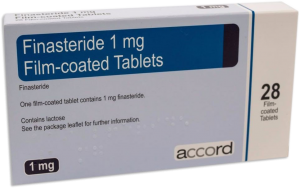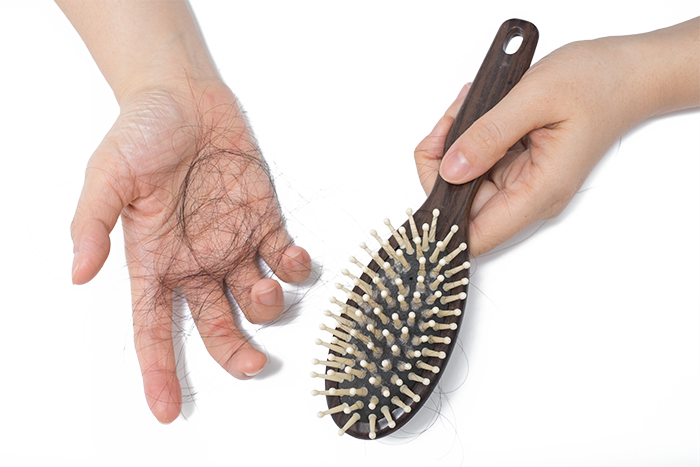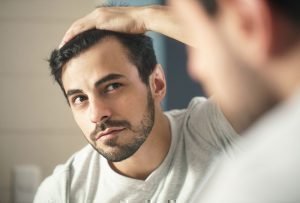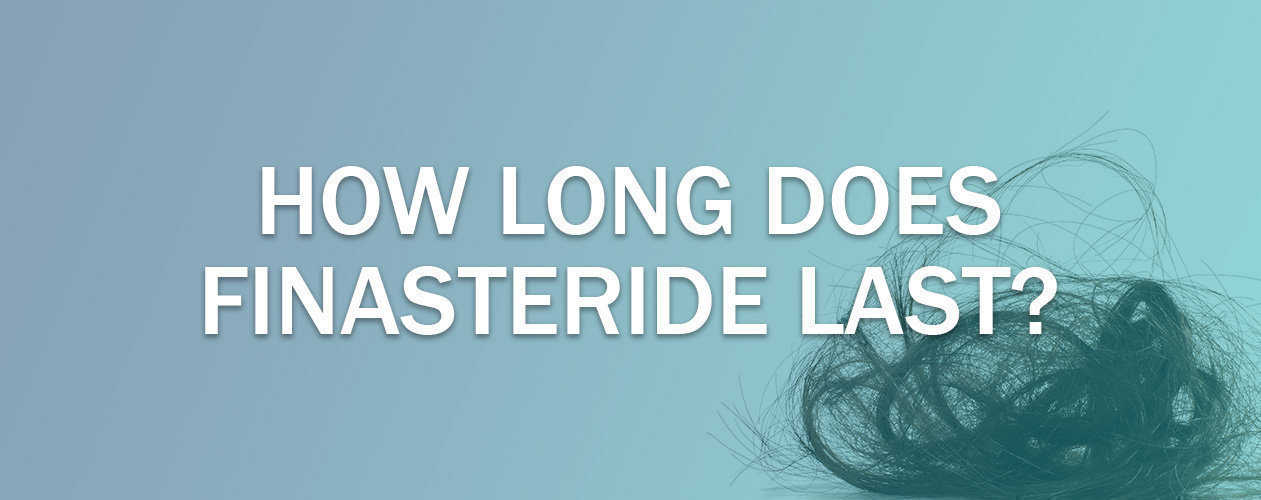How Long Does Finasteride Last?
What is Androgenetic alopecia?
Androgenetic alopecia (AGA) is a hereditary pattern of hair loss where terminal hairs are converted into miniaturized vellus hairs. This type of hair loss is very common with reports showing up to 80% of Caucasian men and 50% of women showing evidence of androgenetic alopecia by 70 years of age.
Men and women, however, typically exhibit different patterns of hair loss. Men tend to have thinning of the hairs in the frontal scalp and scalp vertex, whereas women show thinning of the central scalp. The hair loss seen can lead to a large amount of emotional distress and affect a patient’s quality of life in a negative way leading them to seek treatment. Finasteride is a drug from the class of 5-alpha-reductase (5AR) inhibitors, that is commonly used to stabilize hair loss and promote regrowth.
Is it normal to lose hair on a daily basis?
It is perfectly normal to lose on average about 100 strands of hair every day. However, some people tend to lose more hair than that which results in telogen effluvium. Telogen phase of the hair follicle growth cycle is the natural phase of scalp hair shedding. If hair follicles remain in telogen phase for a longer period of time than usual, it is likely that the person will start shedding hair leaving the scalp exposed. Such a change can be brought about by triggers such as trauma, childbirth, bereavement and even hormonal changes.
Click HERE to View Finasteride Prices > >
What causes hair loss?
Doctors don’t know why certain hair follicles are programmed to have a shorter growth period than others. However, many factors may influence hair loss:
- Hormones;
- Genes, from both male and female parents, may influence a person’s predisposition to male or female pattern baldness;
- Stress, illness, and childbirth can cause temporary hair loss;
- Drugs, including chemotherapy drugs used in cancer treatment, blood thinners, beta-adrenergic blockers used to control blood pressure, and birth control pills, can cause temporary hair loss;
- Burns, injuries, and X-rays can cause temporary hair loss. In such cases, normal hair growth usually returns once the injury heals unless a scar is produced. Then, hair will never regrow;
- Autoimmune disease may cause alopecia areata. In alopecia areata, the immune system revs up for unknown reasons and affects the hair follicles. In most people with alopecia areata, the hair grows back, although it may temporarily be very fine and possibly a lighter colour before normal colouration and thickness return;
- Cosmetic procedures, such as shampooing too often, perms, bleaching, and dyeing hair can contribute to overall hair thinning by making hair weak and brittle. Tight braiding, using rollers or hot curlers, and running hair picks through tight curls can also damage and break hair.
- However, these procedures don’t cause baldness. In most instances hair grows back normally if the source of the problem is removed;
- Medical conditions. Thyroid disease, lupus, diabetes, iron deficiency anaemia, eating disorders, and anaemia can cause hair loss. Most times, when the underlying condition is treated, the hair will return unless there is scarring as in some forms of lupus, lichen planus or follicular disorders;
- Diet. A low-protein diet or severely calorie-restricted diet can also cause temporary hair loss.
Signs of androgenetic alopecia include the following:
- Gradual onset;
- Increased hair shedding;
- Transition in the involved areas from large, thick, pigmented terminal hairs to thinner, shorter, indeterminate hairs and finally to short, wispy, non-pigmented vellus hairs.
How was Finasteride discovered?
Finasteride has an interesting history. Researchers in 1970 reported a group of boys in a specific village in the Dominican Republic that were deficient in the enzyme 5alpha-reductase (5AR). These males had low DHT levels throughout their life. This was associated with two important findings:
- Their prostate glands remained small;
- They did not develop male pattern balding or acne.
From this discovery, researchers worked to create a medication that could block the action of the enzyme 5alpha-reductase. After years of testing, a drug was released into the market. In 1992, the 5 mg dose of Finasteride was approved by the Medicines and Healthcare products Regulatory Agency (MHRA) for the treatment of prostate enlargement. In 1997, MHRA approved a 1 mg dose of Finasteride for the treatment of hair loss.
What is Finasteride?
Finasteride, sold under the brand names Proscar and Propecia among others, is a medication used mainly to treat an enlarged prostate or scalp hair loss in men.
Finasteride, a synthetic 4-azasteroid compound, is a specific inhibitor of steroid Type II 5a-reductase, an intracellular enzyme that converts the androgen testosterone into 5a-dihydrotestosterone (DHT). DHT is a powerful hormone that causes hair follicles to miniaturize and eventually stop growing hair.
Propecia (Finasteride) tablets are film-coated tablets for oral administration. Each tablet contains 1 mg of Finasteride.
Finasteride is considered the first-line treatment for androgenetic hair loss in men.
Finasteride is available only with your doctor’s prescription.

What does Finasteride look like?
Finasteride is a white crystalline powder with a melting point near 250°C. It is freely soluble in chloroform and in lower alcohol solvents but is practically insoluble in water.
How should I take Finasteride?
You may need to take Finasteride by mouth daily for three months or more before you see a benefit from taking it.
Finasteride can only work long term if you continue taking it. If the drug has not worked for you within twelve months, further treatment is unlikely to be beneficial. If you stop taking Finasteride, you will probably lose the hair you have gained within 12 months of stopping treatment. You should discuss this with your doctor.
Take Finasteride at the same time each day.
Finasteride can be administered with or without meals.
The recommended dose of Finasteride is one tablet (1 mg) a day.
Safety and efficacy have been demonstrated in men between 18 to 41 years of age with mild to moderate hair loss of the vertex and anterior mid-scalp area.
Mechanism of action
The mechanism of action of Finasteride is based on its preferential inhibition of Type II 5a-reductase through the formation of a stable complex with the enzyme. Inhibition of Type II 5a-reductase blocks the peripheral conversion of testosterone to DHT, resulting in significant decreases in serum and tissue DHT concentrations, minimal to moderate increase in serum testosterone concentrations, and substantial increases in prostatic testosterone concentrations. As DHT appears to be the principal androgen responsible for stimulation of prostatic growth, a decrease in DHT concentrations will result in a decrease in prostatic volume (approximately 20-30% after 6-24 months of continued therapy). In men with androgenic alopecia, the mechanism of action has not been fully determined, but Finasteride has shown to decrease scalp DHT concentration to the levels found in a hairy scalp, reduce serum DHT, increase hair regrowth, and slow hair loss.
In fact, 83% of the men who take the medicine have successfully stopped male pattern baldness and kept the hair they already have. And 65% of the men who take Finasteride have even experienced a noticeable regrowth of lost hair over the course of three months.
Finasteride doesn’t completely cure male pattern baldness. Instead, it blocks the hormone linked to hair loss in men (DHT) and is only effective for as long as you take the medication. No matter how successful your treatment is and regardless of how much hair you’ve managed to grow back, if you stop taking Finasteride abruptly, you’re not going to like the result. More often, the hair you gained will fall out and the balding process as a whole will resume where it left off.
Think of Finasteride as a way to put male pattern baldness on pause. Still, it’s an incredibly effective tool in the fight against hair loss and the only prescription treatment approved by the MHRA for male pattern baldness.
How long does Finasteride last?
Hair growing is not an immediate process. It takes three to four months to see the results.
Assuming you follow the instructions and take Finasteride every day, you’ll generally start to see results by month three or four. However, it usually takes six to nine months to see the full effects of Finasteride, since hair follicles require plenty of time to produce new hairs.
It’s important to remember that Finasteride doesn’t always cause you to regrow hairs that you’ve previously lost. Most people who take Finasteride do so to stop further hair loss, rather than as a way to regrow hair.
This means that you might not notice any improvement in your hair from Finasteride, even though it’s constantly working by preventing any extra hair from falling out.
It’s also important to remember that your hair will still fall out as part of its natural growth cycle (in order to be replaced by newer hairs), meaning you’ll still notice some stray hairs inside the shower, on your comb or in your hands even after you start using Finasteride.
It takes about one year to see “final” results
Most of the time, you’ll see the “final” results from Finasteride after about a year of using the drug on a daily basis. If you forget to take the pill some days or skip weeks or months of treatment, it can prevent Finasteride from working as effectively as it normally would.
The key thing to keep in mind is that you shouldn’t stop taking Finasteride just because it doesn’t produce any visible improvement in your hairline or hair thickness. If you stop taking Finasteride, your DHT levels will go back to their natural amount and you could start to lose hair again.
When used properly, Finasteride is highly effective at preventing hair loss. Just remember to stay patient while it takes effect since your hair follicles need several months to move into the growth phase and start producing new hair.
How quickly does Finasteride work?
When taken as prescribed, one tablet a day, Finasteride should begin to show results after three months. In some men, it takes longer. For this reason, it is important to stay positive.
But if you have been taking Finasteride for longer than 12 months and you don’t see a difference it is unlikely that the treatment will begin to work after this point. In some cases, it is recommended to speak to your doctor about how to proceed.
Will Finasteride work for me?
For most men, Finasteride increases the number of hair on the scalp in the first year of treatment, helping to fill in thin or balding areas of the scalp. In addition, men taking Finasteride may note a slowing of hair loss.
Although results will vary, generally you will not be able to grow back all the hair you have lost. There is not sufficient evidence that Finasteride works in the treatment of receding hairline in the temporal area on both sides of the head.
Male pattern hair loss occurs gradually over time. On average, healthy hair grows only about half a centimetre each month. Therefore, it will take time to see any effect.
To make sure Finasteride is safe for you, tell your doctor if you have:
- Liver disease, or abnormal liver enzyme tests;
- Prostate cancer;
- A bladder muscle disorder;
- Stricture of your urethra;
- If you are unable to urinate;
- If you have ever had an allergic reaction to a similar medicine called dutasteride (Avodart).
- Pharmacokinetics
The bioavailability of Finasteride 1 mg following oral intake ranges from 26-170% with a mean of 65%. The average peak plasma concentration has been found to be 9.2 ng/ml measured 1-2 hours after administration. The bioavailability of Finasteride is not related to food intake. Finasteride is extensively metabolized in the liver by Cytochrome P450 3A4 enzyme subfamily and excreted both in urine and faeces. The terminal half-life is approximately 5-6 hours in men between 18-60 years of age and 8 hours in men more than 70 years of age.

What are the possible side effects of Finasteride?
Like all prescription products, Finasteride may cause side effects. In clinical studies, side effects from Finasteride were uncommon and did not affect most men. A small number of men experienced certain sexual side effects. These men reported one or more of the following: less desire for sex; difficulty in achieving an erection; and, a decrease in the amount of semen. Each of these side effects occurred in less than 2% of men. These side effects went away in men who stopped taking Finasteride. They also disappeared in most men who continued taking Finasteride.
In general use, the following have been reported: breast tenderness and enlargement; depression; allergic reactions including rash, itching, hives and swelling of the lips and face; problems with ejaculation; testicular pain; and, in rare cases, male breast cancer. You should promptly report to your doctor any changes in your breasts such as lumps, pain or nipple discharge. Tell your doctor promptly about these or any other unusual side effects.
Drug Interactions
No drug interactions of clinical importance have been identified. Finasteride does not appear to affect the cytochrome P450-linked drug-metabolizing enzyme system. Compounds that have been tested in man include antipyrine, digoxin, propranolol, theophylline, and warfarin and no clinically meaningful interactions were found.
Before using this medication, tell your doctor or pharmacist of all prescription and nonprescription/herbal products you may use. Your doctor or pharmacist may already be aware of any possible drug interactions and may be monitoring you for it. Do not start, stop or change the dosage of any medicine before checking with them first.
Who should not take Finasteride?
Finasteride is indicated for the treatment of male pattern hair loss in men only and should not be taken by women;
Finasteride should not be taken by children;
Anyone allergic to any of the ingredients.
Finasteride positives
Best first-line attack. It can dramatically slow and partially reverse hair loss for a high percentage of men;
Generally well-tolerated. It has been used as a hair loss treatment since 1997. It’s UK approved and considered safe by the two of the world’s leading hair loss organizations, the International Society of Hair Restoration Surgeons and British Association of Dermatologists;
Can work for years, even decades; is the most effective, long-term hair loss treatment option on the market today;
Easy to use as directed. Taking a pill every day is no big deal for most people. On the other hand, compliance may be an issue with a hair loss treatment like minoxidil, where the solution must be rubbed into the scalp twice daily.
Does Finasteride (Propecia) lose effectiveness over time?
According to Kaufman et al., >90% of the patients who carry on Finasteride 1 mg >5 years will have positive results regarding hair inhibition and reversion of hair follicle shrinkage, while >66% will grow new hair of normal thickness and length both on the top and frontal area.
Of these patients, about half report minimal hair growth and the rest report moderate or significant hair growth.
Moreover, an extension of the study beyond 5 years showed that Finasteride effectiveness continues, unlike placebo.
On the other hand, you cannot expect any drug to manage to “beat” your genes forever, they can usually effectively slow them down.
Click HERE to View Finasteride Prices > >
References:
- Severi G, Sinclair R, Hopper JL, English DR, McCredie MR, Boyle P, Giles GG. Androgenetic alopecia in men aged 40-69 years: prevalence and risk factors. Br J Dermatol. 2003 Dec; 149(6):1207-13; PubMed PMID: 14674898;
- Jason M. Hirshburg, Petra A. Kelsey, Chelsea A. Therrien, A. Carlo Gavino, Jason S. Reichenberg. Adverse Effects and Safety of 5-alpha Reductase Inhibitors (Finasteride, Dutasteride): A Systematic Review. J Clin Aesthet Dermatol. 2016 Jul; 9(7): 56–62; PMCID: PMC5023004;
- PubMed PMID: 27672412;
- https://www.webmd.com/skin-problems-and-treatments/hair-loss/understanding-hair-loss-basics#2;
- https://emedicine.medscape.com/article/1070167-overview#showall;
- https://www.accessdata.fda.gov/drugsatfda_docs/label/2014/020788s024lbl.pdf;
- Yim E, Nole KL, Tosti A. 5α-Reductase inhibitors in androgenetic alopecia. Curr Opin Endocrinol Diabetes Obes. 2014 Dec;21(6):493-8; PubMed PMID: 25268732; doi: 10.1097/MED.0000000000000112;
- https://www.forhims.com/blog/is-finasteride-the-right-hair-loss-remedy-for-you;
- https://www.drugs.com/mtm/finasteride.html;
- Venkataram M. Finasteride and sexual side effects. Indian Dermatol Online J. 2012 Jan-Apr; 3(1): 62–65; PMCID: PMC3481923; PubMed PMID: 23130269;
- http://www.hairlossdaily.com/propecia-for-hair-loss/;
- Kaufman KD, Rotonda J, Shah AK, Meehan AG. Long-term treatment with finasteride 1 mg decreases the likelihood of developing further visible hair loss in men with androgenetic alopecia (male pattern hair loss). Eur J Dermatol. 2008 Jul-Aug;18(4):400-6; PubMed PMID: 18573712; doi: 10.1684/ejd.2008.0436;
- Whiting DA. Advances in the treatment of male androgenetic alopecia: a brief review of Finasteride studies. Eur J Dermatol 2001 Jul-Aug;11(4):332-4; PubMed PMID: 11399540.
Mens Pharmacy is not liable for the currency or accuracy of the information contained in this blog post. For specific information about your personal medical condition, please contact our doctors or pharmacists for advice on [email protected].

